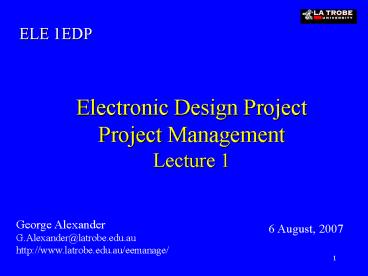Electronic Design Project Project Management Lecture 1 - PowerPoint PPT Presentation
1 / 23
Title:
Electronic Design Project Project Management Lecture 1
Description:
2006 sales = $A30bn (Telstra = $A23bn) In partnership with Sony to produce mobile handsets ... Negotiation skills. Sound business knowledge ... – PowerPoint PPT presentation
Number of Views:25
Avg rating:3.0/5.0
Title: Electronic Design Project Project Management Lecture 1
1
Electronic Design ProjectProject
ManagementLecture 1
ELE 1EDP
George Alexander G.Alexander_at_latrobe.edu.au http/
/www.latrobe.edu.au/eemanage/
6 August, 2007
2
Contact Details
Lecturer George Alexander Department Electroni
c Engineering Office Physical Sciences 2 PS2
129B E-mail G.Alexander_at_latrobe.edu.au Website
http//www.latrobe.edu.au/eemanage/ Availability
Mon, Wed, Fri
PLEASE NOTE when e-mailing type ELE1EDP in the
subject field
3
So far -
- Electronic Systems Design within the business
process tenders, contracts etc. - A closer look at Electronic Systems Design,
including the systems approach.
4
This week and the next few weeks
- Invariably, the Electronic Systems Design is
applied in a project environment. - Now, we look at whats involved in managing such
projects.
5
Reading
- Course is based on -
- Project Management From Idea to Implementation
- Haynes, M.E. Kogan Page, 1990
- Further reading (more detail) -
- The Fast-forward MBA in Project Management
- Verzuh, E. John Wiley Sons Inc. 1999
6
Approach to the topic
- Presentation of the principles of project
management as contained in Haynes text. - Some practical insights into how these principles
have applied in practice at Ericsson - Relating this to the EDP project
7
ERICSSON
- Headquarters in Stockholm, Sweden
- Currently employs 64,000 people in 140 countries
16,000 in RD (Telstra 50,000) - Largest global supplier of mobile systems
- 40 of total traffic through Ericsson systems
- 2006 sales A30bn (Telstra A23bn)
- In partnership with Sony to produce mobile
handsets - In Australia
- Main customers Telstra, Vodafone, Hutchison
- Regional support for Asia Pacific region
- Until 2003, major design centre
8
Project Management as a Career
- Good project managers are very highly regarded
and well rewarded. - Skills required include
- People management skills
- Appreciation of the technical issues involved
- Negotiation skills
- Sound business knowledge
- Formal qualifications at various levels are
becoming the norm. - Good project managers make things happen on
time, on budget, with quality outcomes. They are
good for business. - Institutes PMI, AIPM
9
WHAT IS A PROJECT?
- A project is an undertaking which has a clear
beginning and end. - Established to achieve defined task with specific
cost and quality objectives. - Optimises the use of available resources
skills, tools, systems. - Team-based
- Driven by customer/market demand
10
In what way is Project Management different?
- Projects have finite life spans. Other
organisation units exist indefinitely. - Projects often require resources on a part-time
basis. Permanent organisations try to use
resources full-time. - Sharing of resources frequently leads to conflict
over priorities.
11
Project vs line organisation
- Engineers permanently belong to a line
organisation e.g. a design department, which is
responsible for their training, salary levels
etc. - Engineers are assigned to projects for a given
period usually full-time. - The line organisation is responsible for the
future planning/provision of the required numbers
and skills to accommodate the overall project
needs resource planning.
12
MANAGING BUSINESS AND ENGINEERING
PROJECTSConcepts and Implementationby John M
Nicholas 1990 Prentice Hall
13
Types of Projects
- Research
- Development
- Problem Solving
- Construction
- Manufacturing Technical Projects
- Business
14
Types of project
- Projects vary in terms of
- Size
- Duration
- Urgency
- Dedicated/shared resources
- Capital intensive
- Labour intensive
- Local or global focus
15
Examples of Projects
- New robotic line
- New manufacturing plant
- Quality improvement projects (AQA)
- New computer system (Y2K)
- Design of rural telephone exchange
- Design of new exchange processor
- Roll-out of 3G mobile network - Hutchison
- Roll-out of Telstras NEXT G
- Relocation of test plants
16
The Project Life Cycle
- According to Haynes there are four phases
- Conceiving and defining the project
- Planning the project
- Implementing the plan
- Completing and evaluating the project
- Activity levels vary during each phase
17
Reasons for Design
- New technology generation
- New component technology
- New production technology
- Need for product enhancements
- Priority determined by urgency
- Highest priority redesign now, retrofit
- Non-urgent redesign for next product release
18
(No Transcript)
19
(No Transcript)
20
Project Evolution
- Client (internal/external) demand
- Prestudy
- Feasibility study including business case,
organisation, defining competences and
availability, time plan - Project execution team building, continuous
monitoring, reporting, risk analysis - Project wash-up, including final report
21
The importance of the early phases
- Clearly defining client needs
- Getting input from the experts
- Exchange of information client and experts
- Absolutely clear definition of the project
specification common understanding
22
Next week -
- We take a closer look at these early but very
important - phases of the project.
23
Thanks for your attention































